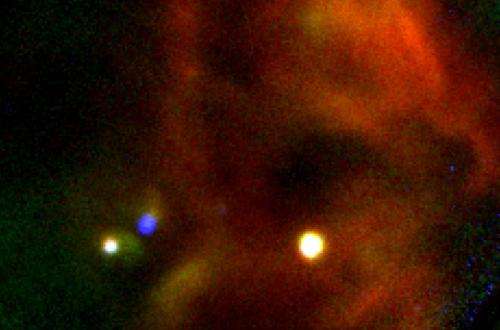NASA's airborne observatory views star forming region W40

A new image from NASA's Stratospheric Observatory for Infrared Astronomy, or SOFIA, provides the highest resolution mid-infrared image taken to date of the massive star formation region in our galaxy known as W40.
The W40 image was taken by the Faint Object infraRed Camera for the SOFIA Telescope (FORCAST) instrument mounted in the airborne observatory – a highly modified 747SP airliner carrying a reflecting telescope with an effective diameter of 100 inches (2.5 meters). The image of W40 is a composite of data captured by the FORCAST camera at infrared wavelengths of 5.4, 24.2, and 34.8 microns, all of which are partially or completely blocked by water vapor in Earth’s atmosphere and inaccessible to observatories even on high mountain tops.
W40 is difficult to view with optical telescopes because it lies on the far side of a very dense cloud of gas and dust. Infrared observations of the region peer through the dust to reveal a bright nebula and dozens of young stars with at least six massive stars, six to 20 times the mass of the sun, forming at the center.
At least 50 percent of the stars in the Milky Way Galaxy formed in massive clusters of thousands of stars similar to W40. Evidence suggests that the solar system developed in such a cluster almost 5 billion years ago. Because stars are relatively dim at the wavelengths measured by FORCAST, the observed emission in the images is due to dust surrounding the stars that is heated to a few hundred degrees.
SOFIA is a joint project of NASA and the German Aerospace Center (DLR), and is based and managed at NASA's Dryden Aircraft Operations Facility in Palmdale, Calif. NASA's Ames Research Center in Moffett Field, Calif., manages the SOFIA science and mission operations in cooperation with the Universities Space Research Association (USRA), headquartered in Columbia, Md., and the German SOFIA Institute (DSI) at the University of Stuttgart.
Provided by JPL/NASA




















